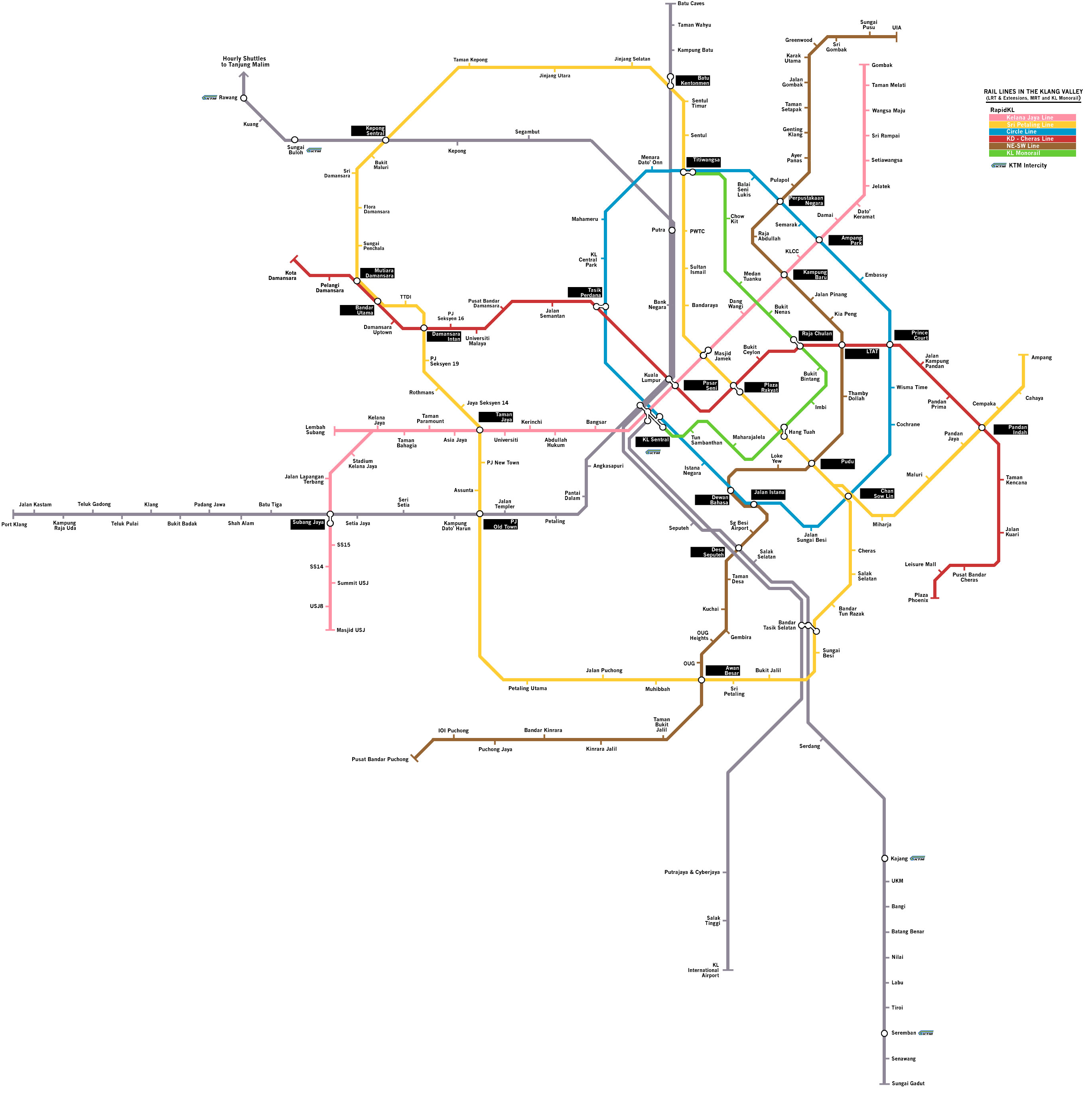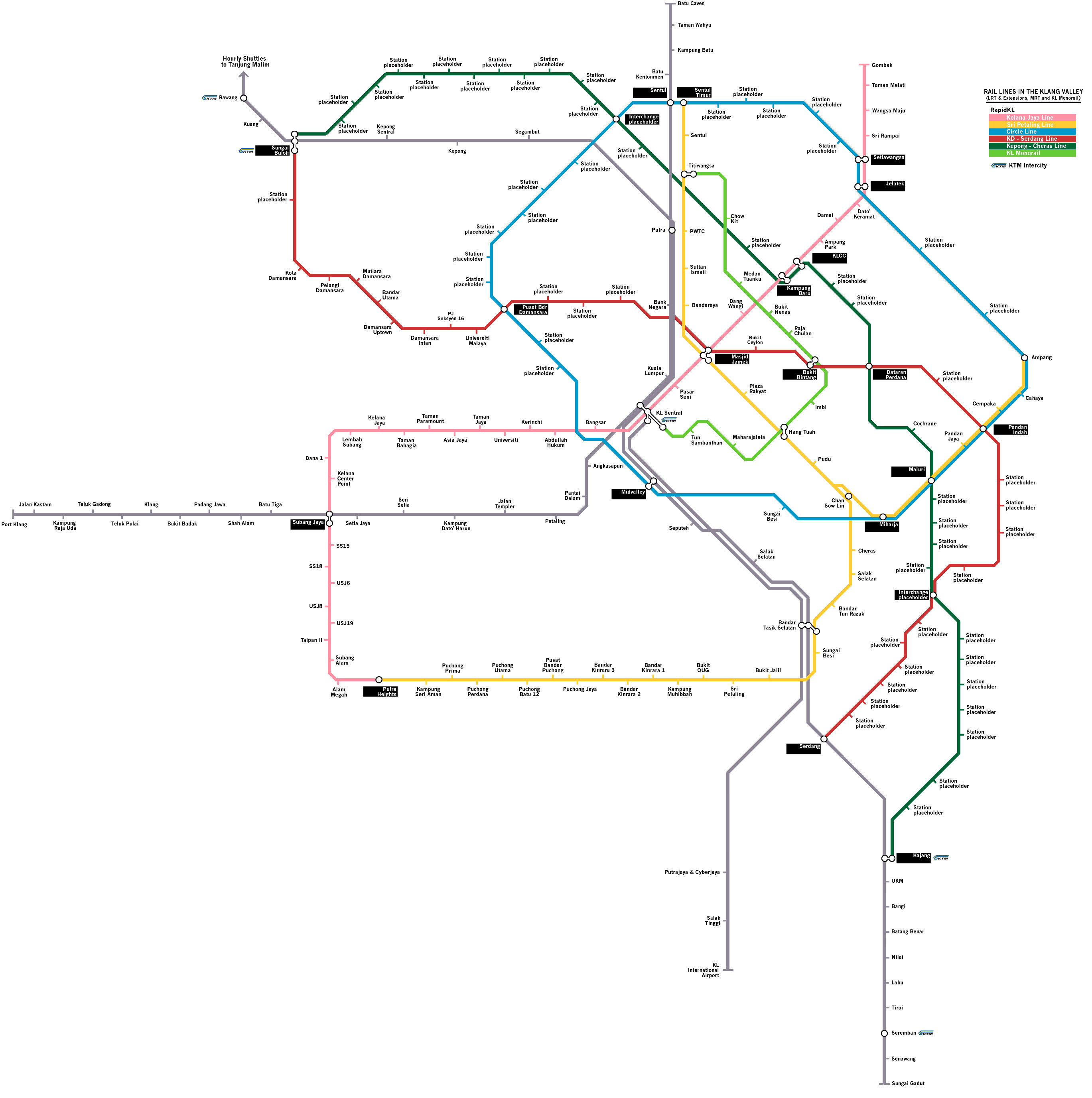In this post, KVMRT will examine the 4 “main” rail network proposals for the Klang Valley, which come from:
Fikir Runding (2007) – the 4th image
DBKL (2008) – (Coming Soon!)
Prasarana (2009) – original / in the 3rd image
MMC-Gamuda (2010) – in the 5th image (below) / The Star / Malaysian Insider
The current rail network for Klang Valley. Drawing courtesy of @Bukhrin
The current proposed LRT extensions from Prasarana – drawing courtesy of @Bukhrin
The current proposed LRT extensions from Prasarana along with a new proposed line serving the northwest-southeast corridor – drawing courtesy of @Bukhrin.
This proposal from Fikir Runding in 2007 with the key feature of radiating lines and two circle lines – drawing courtesy of @Bukhrin.
MMC-Gamuda proposal for Klang Valley rail network from 2010 – drawing courtesy of @Bukhrin
Graphic from the Malaysian Insider shows proposed phases for the "unsolicited", "unapproved" MRT project. MMC-Gamuda would like very much for this project to get started next year.
The StarBiz "snapshot of the MRT proposal" showcasing its "advantages" - Image courtesy of Star Biz
StarBiz graphic showing the proposed routing for the City Circle Line
The Gamuda-MMC proposed MRT network consists of two radial lines and a circle line, which has similarities with the train networks in most major cities. It is commonly known as the “wheels and spokes” concept.
In total, the MRT network will cover up to 150km of lines, with about a third of that going underground.
The first radial line, dubbed the red line, will go from Damansara to Serdang and the second one (the green line) will be from Kepong to Cheras.
Both lines will cross the centre of Kuala Lumpur city and will converge in the city centre, at Dataran Perdana near Jalan Tun Razak.
Multiple “Seamless” Interchanges
The proposal suggests that there is a need for additional interchanges between LRT and MRT stations in the Klang Valley and will plan the MRT lines to maximize the number of available interchanges.
The interchanges are also being described as “seamless” and designed in the same manner as interchanges in Hong Kong, Singapore and Kaohsiong.
Similar interchanges are proposed for the Fikir Runding, DBKL and Prasarana proposals, at different sites. For example, Prasarana proposes that KL Sentral stay as a main interchange, while the MMC-Gamuda and DBKL proposals seem to prefer Masjid Jamek.
[KVMRT: Interchanges and network nodes are very important aspect in the network and having many interchanges will allow better flow of passenger movement throughout the network. In addition, the development potential for sites around interchanges is high - which can help to offset the cost of construction.
After having been exposed to the poorly designed interchanges in the existing rail network (particularly Kuala Lumpur-Pasar Seni and KL Sentral-KL Monorail) we do not think there would be objections to this.]
Underground construction
The proposal from MMC-Gamuda has a idea of utilizing underground construction proposed for the two main lines along the “northwest-southeast” corridors. Most of the City Centre line would be elevated (except the western stretch).
This contrasts interestingly with the DBKL proposal (which consists mostly of elevated monorail lines) and the Prasarana proposal (which will only be underground from Brickfields to Bukit Bintang). We have no details about the Fikir Runding proposal.
[KVMRT: As you can imagine, the cost of underground construction is almost twice higher than the cost of elevated construction - and with MRT trains being wider than LRT trains, the rolling stocks cost will surely be higher. There is also the issue of the land under KL - which has many open caverns and underground rivers. It will be challenging task for engineering aspect in proper corridors for tunneling.]
Rail good, bus bad
All of the proposals above are rail-based, and they mostly argue that the existing bus system will not be able to meet future public transport demand.
While the proposals (with the exception of Fikir Runding) do have varying degrees of bus usage incorporated in the design, it is clear that rail is in great favour.
The MMC-Gamuda proposal goes ahead to say that the SPAD proposal for bus lanes and BRT is unworkable because of congestion (shown in photos) on the existing roads where these routes have been proposed.
The MMC-Gamuda proposal takes a highly “selective” (biased) approach by using a photo of the TransMilenio BRT system in Bogota that suggests that the system will simply lead to more traffic congestion.
[KVMRT: Selection examination of the details and all the options is nothing new.
The key issue is what is behind that selective examination of the details. Can DBKL, Prasarana, Fikir Runding and MMC-Gamuda say that they do not have a huge financial stake in the future rail network for the Klang Valley?
That is why these proposals should be examined publicly, in an open and transparent manner - so that the ideas, thoughts, feeling and biases become clear and what emerges is the best possible choice.
It is also why we really prefer it that proposals do not come to the government from companies that have a direct interest in the proposal. ]
Feedback
Klang Valley MRT admin needs your feedback on the above proposals – evaluating the advantages and disadvantages – and suggestions on what network would be best for the needs of the Klang Valley.
Thank you for staying tune with KVMRT. The above analysis is done with close reference to TRANSIT.








